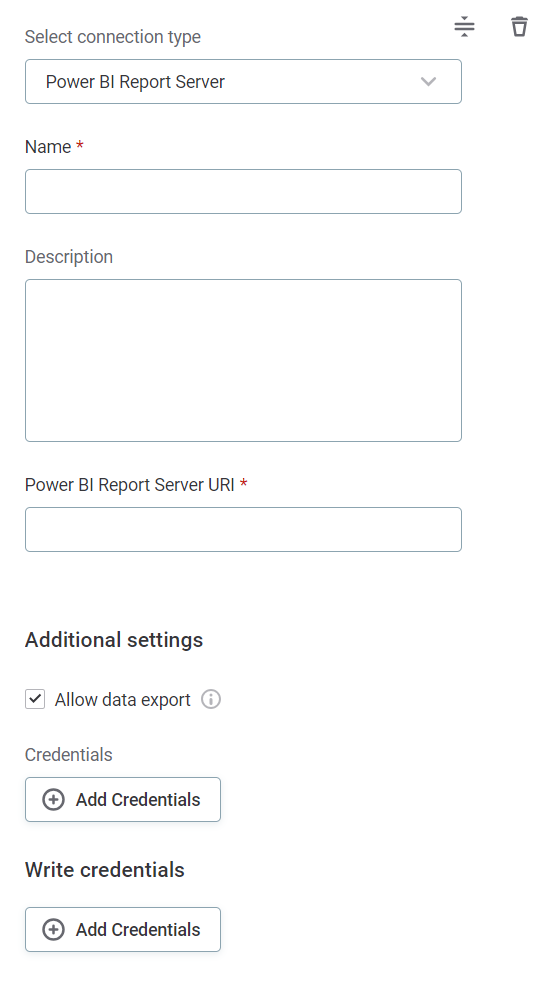Power BI Report Server Connection
Power BI Report Server is an interactive data visualization tool that focuses primarily on business intelligence and is part of the Microsoft Power Platform. Setting up a connection to Power BI Report Server is a prerequisite for importing Power BI Report Server reports to ONE. For more information about reports, see Reports.
|
There is a separate connector for the cloud-based Power BI solution, see Power BI Connection. |
Create a source
To connect to Power BI Report Server:
-
Navigate to Data Catalog > Sources.
-
Select Create.
-
Provide the following:
-
Name: The source name.
-
Description: A description of the source.
-
Deployment (Optional): Choose the deployment type.
You can add new values if needed. See Lists of Values. -
Stewardship: The source owner and roles. For more information, see Stewardship.
-
| Alternatively, add a connection to an existing data source. See Connect to a Source. |
Add a connection
-
Select Add Connection.
-
In Select connection type, choose Reporting tools > Power BI Report Server.
-
Provide the following:
-
Name: A meaningful name for your connection. This is used to indicate the location of catalog items.
-
Description (Optional): A short description of the connection.
-
Power BI Report Server URL: The URL of the web portal for Power BI Report Server.
This URL must also be added to Content Security Policy directives in ONE. See step Configure the Content Security Policy. 
-
-
In Additional settings, select Allow exporting and loading of Data if you want to export data from this connection and use it in ONE Data or outside of ONE.
Consider the security and privacy risks of allowing the export of data to other locations.
Add credentials
| Only NTLM authentication is supported. |
-
Select Add Credentials.
-
Provide the following:
-
Name (Optional): Enter a name for this set of credentials.
-
Description (Optional): Provide a description for this set of credentials.
-
Select a secret management service (optional): If you want to use a secret management service to provide values for the following fields, specify which secret management service should be used. After you select the service, you can enable the Use secret management service toggle and provide instead the names the values are stored under in your key vault. For more information, see Secret Management Service.
-
Username: The username for the data source. Alternatively, enable Use secret management service and provide the name this value is stored under in your selected secret management service.
-
Password: The password for the data source. Alternatively, enable Use secret management service and provide the name this value is stored under in your selected secret management service.
These should be the same credentials used to access the Power BI Report Server web portal.
-
-
If you want to use this set of credentials by default when connecting to the data source, select Set as default.
-
Proceed with Test the connection.
Test the connection
To test and verify whether the data source connection has been correctly configured, select Test Connection.
If the connection is successful, continue with the following step. Otherwise, verify that your configuration is correct and that the data source is running.
Save and publish
Once you have configured your connection, save and publish your changes. If you provided all the required information, the connection is now available for other users in the application.
In case your configuration is missing some required fields, you can view a list of detected errors instead. Review your configuration and resolve the issues before continuing.
Finish setting up the connection
Configure the Content Security Policy
To see the reports preview and thumbnails of your Power BI reports in ONE and use images in a rich text editor, admins need to configure the content security policy. It is sufficient to add the Report Server web portal URL in the Frame src field.
To do this, go to Global Settings > Content Security Policy and select Create. Provide a name and a description and select the policy owner.
Next, in the Frame src field enter the HTTP directive that specifies valid sources for nested browsing contexts loading using elements such as <frame> and <iframe>.
In our case, this is the URL of the Report Server web portal.
To add more than one value for the directive, select Add.
Select Save and publish your changes.
For more details, see Content Security Policy Configuration.
Manage access rights
Make sure you have the corresponding Full, Edit, or View data access rights in ONE:
-
On sources to import reports from your BI tool.
-
On reports to manage their preview.
For more information, see Share Access to Assets
Next steps
You can now import your Power BI Report Server reports to ONE.
In Data Catalog > Sources, find and open the source you just configured. Switch to the Connections tab and select Import Alternatively, opt for Discover or Discover documentation flow.
Or, to import only some assets, select Browse on the Connections tab. Choose the assets you want to analyze and then the appropriate importing or profiling option.
To learn more about reports in ONE, see Reports and Reports from Power BI.
Was this page useful?
